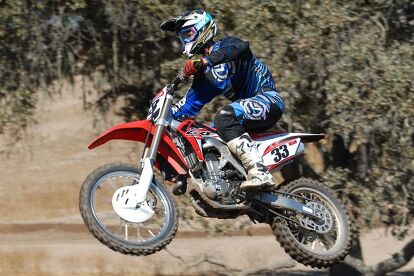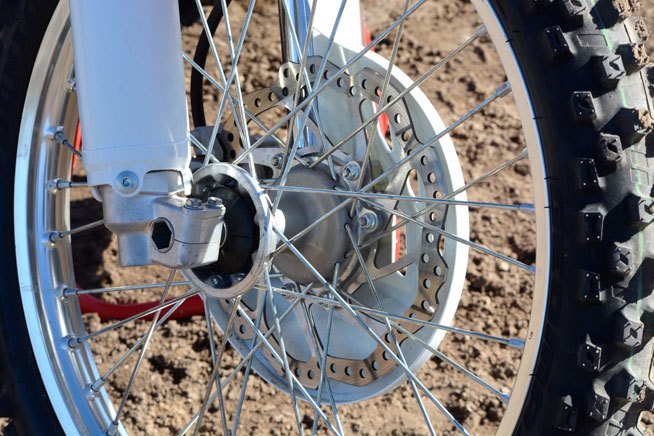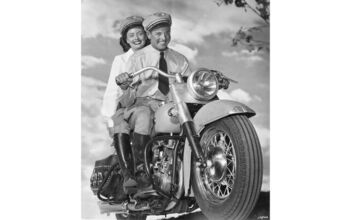2015 Honda CRF450R First Ride Review
Updates include adjustable engine modes, a new suspension and revised engine tuning
Honda released the details of its 2015 Honda CRF450R last June, and we have been anxiously awaiting the chance to throw some roost on it ever since. That chance finally came this week, as Honda invited us to the picturesque Zaca Station MX Park north of Santa Barbara, California, to sample its latest red rooster. We’re happy to report that the 2015 model boasts updates to make it even more competitive in what is a brutally intense category.
2015 Honda CRF450R
| Engine | 19.0/20 |
| Suspension/Handling | 14.0/15 |
| Transmission/Clutch | 10.0/10 |
| Brakes | 10.0/10 |
| Instruments/Controls | 5.0/5 |
| Ergonomics/Comfort | 8.5/10 |
| Appearance/Quality | 9.0/10 |
| Desirability | 9.0/10 |
| Value | 9.0/10 |
| Overall Score | 93.5/100 |
Of the key changes made to the CRF450R, many of them center on its 449cc, liquid-cooled, Unicam (SOHC), four-valve, four-stroke Single. The goal for 2015 was to give the 450 livelier midrange and top-end performance without hurting its low-end grunt. The CRF450R’s engineers tackled this mission by designing a new cylinder head that retains the same combustion chamber shape and same size titanium intake and steel exhaust valves as before, but its exhaust port has been revised.
The exhaust port now exits to the right of center when viewed from the front, and Honda engineers have altered the exhaust header length so the header no longer wraps around the downtube on the CRF450R’s aluminum perimeter frame. The shorter header length, combined with redesigned mufflers that have a larger internal diameter, help the CRF450R strike a balance between the smooth torque of the 2014 model and the increased midrange/top-end goals of the 2015 model. To raise the rpm at which the CRF450R’s peak power occurs, revised ignition timing and fuel settings for the Dual-Timing PGM-FI fuel injection were also incorporated.
Of course, the 2015 CRF450R also receives Honda’s latest innovation, the Engine Mode Select button, which allows the rider to access multiple EFI/ignitions maps stored in the CRF450R’s ECU simply by pressing a button mounted on the right side of the handlebar. A popular feature on top-shelf sportbikes for the past five years [oddly, Honda’s own CBR600RR and CBR1000RR sportbikes don’t have this feature -Ed.], it is an industry first among motocross machines, and we expect it to proliferate because of its ease of use. The system stores three different EFI/ignition maps. The first is the stock map, which cannot be altered, but the other two are custom maps that can be reprogrammed via an HRC accessory tuning tool. As delivered, Mode 2 alters the ignition timing and fuel curve to enhance traction on slippery surfaces, while Mode 3 is more aggressive for deep or high-traction surfaces. It is important to note, however, that the system does not include a holeshot mode.
Deep and loamy best describes the Zaca Station circuit, and Honda naturally made sure the facility was well-groomed for our intro. Test rider Ryan Abbatoye jumped on the CRF450R and quickly got comfortable aboard the machine. After about an hour of railing corners and soaring over Zaca’s jumps, including the track’s signature jump, the mountainous step-up located right in the middle of the course, Abbatoye started to deliver his impressions.
The 2015 CRF450R’s power delivery is noticeably improved over last year’s model even though its peak power output is unchanged. There is a very electric, very hooked-up feel to its engine, which transitions smoothly and seamlessly from bottom to top, making the CRF450R easy to ride for novices while still delivering plenty of top-end for pros. It isn’t the most exciting 450cc engine we’ve tested this season, but it’s far from boring. If we had to guess at the CRF450R’s rear-wheel hp output, we’d say that it is somewhere in-between the “mello yellow” Suzuki RM-Z450 and the powerhouse Yamaha YZ450F. The Honda feels as if it pulls longer than the Suzuki but not with quite the same authority as the Yamaha.
However, the Engine Mode Select feature does make a noticeable difference, and we really like how easy it is to use. Simply pull in the clutch and push the button. A flashing light will appear with a corresponding cadence that lets you know whether you are in Mode 1, 2 or 3. Overall, Abbatoye preferred Mode 1, the stock setting. Just as with the CRF250R, he felt that Mode 3, the aggressive mode, traded away too much top-end pull for better mid-range zip.
Shifting is typical Honda perfection. Its five-speed gearbox and multi-plate clutch deliver smooth shifts and linear action. However, the Honda’s torque curve feels broad enough that the rider has the option of being able to short-shift the engine or simply let it carry a gear and rev.
Handling and suspension are as important to fast lap times as a thundering motor, and while the CRF450R’s aluminum perimeter chassis has not undergone any changes for 2015, its suspension has, at both ends. The big news is up front, where a new version of the Honda’s 48mm KYB Pneumatic Spring Fork (PSF) resides in its cast aluminum triple clamp. First of all, allow us to digress by noting that, while Honda owns Showa, it specs a KYB fork for the CRF450R (the CRF250R uses Showa) and is the only Japanese 450cc motocross manufacturer to use the PSF fork. Suzuki and Kawasaki use Showa SFF-Air forks, while Yamaha’s KYB Separate Function fork (SFF) still features steel coil springs.
So what makes the KYB PSF different? To find out, Honda had KYB officials on hand to walk us through the fork. The PSF is designed to compartmentalize the compression and rebound adjustments similar to the SFF, but the technical highlight of the fork is having high- and low-speed adjusters on both sides, giving the PSF an amazingly fine degree of tuneability. The compression damping circuit is located in the left leg, and the rebound damping circuit is in the right leg, with the valve specs being the same on both sides. The fork is also self-lubricating. When the fork compresses, the displaced oil travels through a bleed port at the bottom of the shock and through the space between the inner and outer fork tubes, reducing friction. KYB has also taken contamination defense to the next level by adding a dust scraper between the dust seal and the oil seal on each fork leg. It is basically a second line of defense against any debris that makes it past the dust seal.
Out back, Honda made changes to the CRF450R’s KYB piggyback-reservoir shock in order to better manage its 12.4 inches of rear wheel travel. The suspension updates include new high- and low-speed compression adjusters for 2015, as well as the usual rebound damping adjuster, but the rebound damping adjuster has been moved to a new location; it is nestled with the compression adjusters, just above the oil reservoir, making access to all three adjustments a snap.
In a word, the CRF450R’s KYB suspension is forgiving. Whether Abbatoye was hammering a G-force landing while completing one of the track’s big jumps or pounding through ruts, the KYB suspension offered a smooth stroke at both ends without bottoming. With 12.2 inches of front wheel travel available, the fork’s excellent control should inspire confidence in Novice riders. The shock balances nicely with the fork, aided by Honda’s rising-rate linkage rear suspension to keep the rear end in line at all times. It helps the CRF450r maintain consistently good traction at all times, especially during hard acceleration out of rutted corners.
The revised suspension also influences the CRF450R’s handling, and it’s mostly for the better. With a 58.7-inch wheelbase, 27-degree steering head angle and 4.6 inches of trail, the CRF450R’s numbers don’t significantly set it apart from other chassis in the class, so suspension performance really comes into play. Honda got it right with the KYB suspension this year.
“In the past, Hondas have always felt ‘stinkbug’ to me, where the front end is low and the rear end is high, which makes the chassis unstable,” Abbatoye said. “Now it feels more balanced front to rear, and it is way more stable. I know that Honda was aware of the stinkbug issue, and they worked really hard to change it. They did, and it’s more planted, more predictable and not as twitchy now. It’s a big improvement.
On the other hand, it isn’t perfect.
“No, I do have one complaint,” Abbatoye added. “I noticed that while the front end tracked well in ruts, it wanted to wash out on some of the ridges that were forming in some of the turns at Zaca. Every bike will do it to some degree, but the Honda is more sensitive to it. So, I had to check up for stuff like that or be more careful with my line selection. I chose a couple different lines just for that reason. But overall, the chassis is really good, and the faster you go the better it gets.”
Brakes and tires are two more areas where the CRF450R has received attention in 2015. Up front, the Honda gets a new, 20mm larger rotor, measuring 260mm in diameter, while the 245mm rear rotor now features more of a wave pattern design than the previous version. Both are clamped by Nissin calipers, a two-piston unit up front and a single-piston unit out back. Are they improvements of the same magnitude as the engine and suspension? Not really, but that’s no big knock, according to Abbatoye.
“Honestly, Honda has always been known for having good brakes, and Zaca is a really fast track that doesn’t require a lot of brakes,” Abbatoye said. “The CRF’s brakes are plenty powerful and very linear. I like them.”
Dunlop’s MX32 and MX52 tires may just be the single hottest off-road product to be introduced in 2014, and the CRF450R is fitted with MX52s at both ends. The tires offer tremendous grip and smooth, almost roadbike-like transitioning from straight up to heeled-over in a corner. They are a perfect match for the CRF’s chassis.
Ergonomically speaking, the CRF450R feels the same as the CRF250R that we tested in late May, and we have the same issue with it. Overall, the CRF’s slim cockpit layout is very comfortable, with a smooth seat and a classic handlebar bend that aids in rider comfort, but once again Abbatoye complained about the angularity of the CRF’s radiator shrouds, noting that they are boot catchers. Honda’s race teams reportedly like to trim and/or zip-tie the shrouds to make them less prone to snagging, and we expect that the 2016 models will see a revision here.
Our overall impression, though, is that Honda has done an excellent job with the 2015 CRF450R, and we expect it to be a serious contender for best-in-class honors. Its approach is a little less aggressive and a little more polished than some of its competition, and it is clearly a machine capable of keeping pros happy while helping less experienced riders transition to that next skill level. The Engine Mode Select button alone goes a long toward accomplishing that, and the new KYB PSF fork is extremely impressive.
You can expect to be seeing red at your local motocross track this season.
| 2015 Honda CRF450R Specifications | |
|---|---|
| MSRP | $8699 |
| Engine Type | 449cc liquid-cooled single-cylinder four-stroke |
| Bore and Stroke | 96.0mm x 62.1mm |
| Compression Ratio | 12.5:1 |
| Valve Train | Unicam, four-valve; 36mm intake, titanium; 31mm exhaust, steel |
| Induction | Dual-Timing PGM-FI, 46mm throttle body |
| Ignition | Full transistor with electronic advance |
| Transmission | Close-ratio five-speed |
| Final Drive | #520 chain; 13T/48T |
| Front Suspension | 48mm inverted KYB PSF (Pneumatic Spring Fork) with air-adjustable spring rate, and rebound and compression-damping adjustability; 12.2 inches travel. |
| Rear Suspension | Pro-Link® KYB single shock with adjustable spring preload, rebound damping adjustability, and compression damping adjustment separated into low-speed and high-speed; 12.4 inches travel |
| Brakes | |
| Front | Single 260mm wave-style disc with twin-piston caliper |
| Rear | Single 240mm wave-style disc |
| Tires | |
| Front | Dunlop MX52 80/100-21 |
| Rear | Dunlop MX52 120/80-19 |
| Wheelbase | 58.7 inches |
| Rake | 27° 04’ |
| Trail | 116mm (4.6 inches) |
| Seat Height | 37.5 inches |
| Ground Clearance | 13.0 inches |
| Fuel Capacity | 1.7 gallons |
| Color | Red |
| Claimed Curb Weight* | 243.0 pounds |
| *Includes all standard equipment, required fluids and full tank of fuel – ready to ride. | |
More by Scott Rousseau































































Comments
Join the conversation
Braaaap!!!
it all changes when your little five year old who has been racing bmx for two years and tears up his ktm50 sxc says daddy I want to get on the startline and drag race.... time to purchase another crf450r